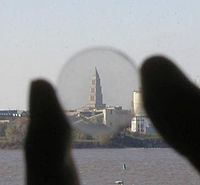
Photo from wikipedia
Transparent spinel ceramics were additively manufactured by laser direct deposition, a blown powder additive manufacturing (AM) process. With a laser melt-growth process, the need for powder binders and postprocessing procedures… Click to show full abstract
Transparent spinel ceramics were additively manufactured by laser direct deposition, a blown powder additive manufacturing (AM) process. With a laser melt-growth process, the need for powder binders and postprocessing procedures was eliminated. Transparent spinel ceramic samples were directly fabricated from micrometer-size magnesium aluminate spinel powders. The optical transparency of the printed spinel samples was mainly affected by residual porosity and cracking. Among other processing conditions, powder flow rate and laser power showed the most significant effects. An obvious transition from opaqueness to transparency was observed after reducing the powder flow rate below 0.1 g/min. The optical transmittance, morphology, and phase composition of the printed spinel samples were systematically investigated. Microstructural aspects including porosity, cracking, and grain size were also characterized. A maximum optical transmittance of 82% was obtained at a wavelength of 632.8 nm, which was nearly comparable to that of their traditionally sintered counterparts. As the laser power increased, residual porosity steadily decreased, with a minimum porosity of 0.2% achieved. Meanwhile, the total crack length obviously increased, while a relatively smaller variation of the average crack length was observed. The measured mechanical properties, including hardness and fracture toughness, were found to be nearly comparable to those of their sintered counterparts. These well demonstrated the potential of the proposed laser AM method in the direct fabrication of transparent ceramics.
Journal Title: Journal of Laser Applications
Year Published: 2021
Link to full text (if available)
Share on Social Media: Sign Up to like & get
recommendations!